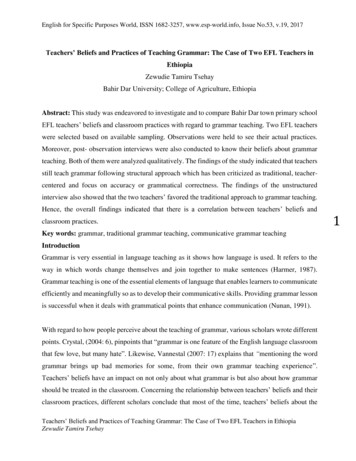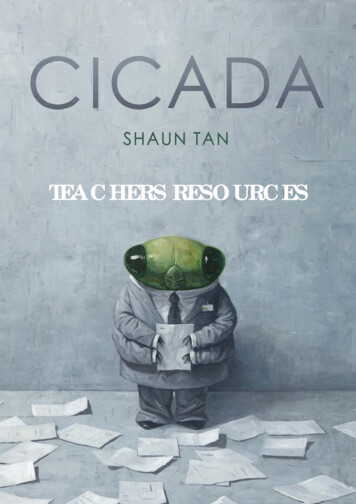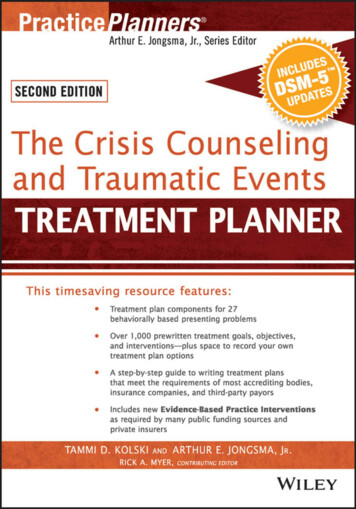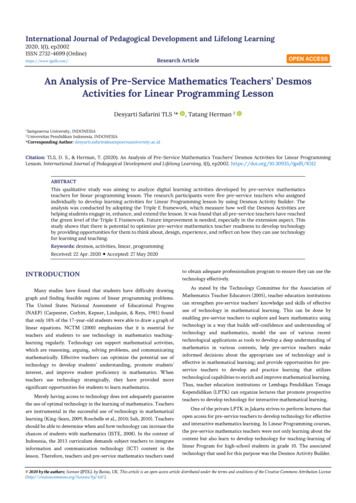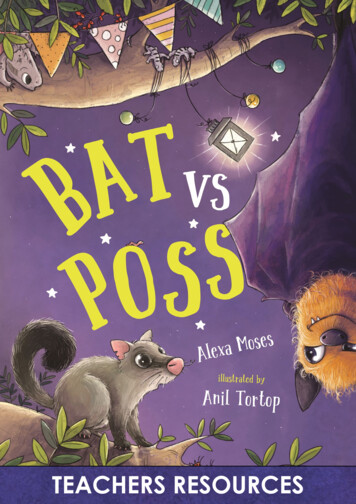
Transcription
TEACHERS NOTESTEACHERS RESOURCES1
BAT VS POSSWRITTEN BY ALEXA MOSESILLUSTRATED BY ANIL TORTOPTeachers Resources by Robyn Sheahan-BrightIntroduction3Themes and Curriculum Topics4Study of history, society and environmentEnglish language and literacyVisual literacyCreative artsLearning technologiesFurther Topics for Discussion and Research7Conclusion7About the Author8About the Illustrator8Worksheets9Bibliography14About the Author of the Notes162
INTRODUCTIONMeek the possum and her three sisters are perfectly happy and contentedsharing their paperbark tree with a horde of other creatures – until the daySquabbles the bat moves in. His noisiness and unsociable behaviour initiallydrives them all away. But they refuse to abandon their idyllic habitat andso hatch a plan to foil the bat at his own game.This is a lively and entertaining story for young children about the joys ofsharing and making friends. Illustrated in animated style by Anil Tortop,whose images perfectly match the effervescent rhyming text written byAlexa Moses.Children will enjoy the cunningly detailed images in which various creaturesprovide a cacophony of action and sound. Set in an inner city street wherethe tree is adjacent to neighbouring terrace houses, this book also suggeststhat animals and human beings can happily live in proximity to each other.It is a celebration of community, and by the end of the story everyone in itis deliriously happy to share both the tree and each other’s company!3
THEMES & CURRICULUMTOPICSSeveral themes are covered in this book which might be related to theAustralian Curriculum, including:STUDY OF HISTORY, SOCIETY AND ENVIRONMENT Natural environment – Possums, bats and other Australian creaturesACTIVITY: Fruit bats are also known as ‘megabats’ or ‘old world fruit bats’.They belong to the Pteropodidae family. Research these creatures.ACTIVITY: Possums are endearing creatures but students might be surprisedto hear that possums are also regarded as pests in some domestic settings,just as this bat is in the book! Research possums and their habitats.ACTIVITY: Apart from possums and fruit bats, many Australian creatures arementioned in this text: birds such as kookaburras, magpies, miner birds, andreptiles such as blue-tongued lizards. What other creatures did your studentsfind in these pages? Invite them to conduct research on an animal of theirchoosing. [See also Worksheet 4.] Friends and friendshipDISCUSSION POINT: These possums are obviously very friendly with theirneighbours. What signs of that friendliness can students identify in theseimages and in their actions?DISCUSSION POINT: What aspects of friendship are explored in this text?DISCUSSION POINT: Invite students to write a short piece about why friendsare important and to share their thoughts by collecting all their pieces ofwriting on a notice board.4
SharingDISCUSSION POINT: Squabbles the bat finally learns the lesson that sharing ismore fun than keeping things selfishly to himself. Do the possums and othercreatures learn anything from their encounter with Squabbles?ACTIVITY: Discuss sharing with students and how this has made their livesmore enjoyable. What things have they shared? For example, what feelingsdo they have when they share a favourite book or toy with someone else?What feelings do they have when someone refuses to share things withthem? English language and literacyACTIVITY: Examine the use of rhyming language in this text. Have funwriting another verse for this book.ACTIVITY: Write an acrostic poem using the letters in ‘possum’. Write ahaiku or tetractys poem on the theme of refugees. [See Worksheet 2.]ACTIVITY: Test your students’ comprehension by asking them questionsabout the written and visual text. Visual literacyThe visual text of a book combines with the written text to tell the story usingthe various parts of the book’s design and illustrations, as explored below:ACTIVITY: The cover of a book is an important part of its message. Whatartistic techniques does the artist use to convey the meaning of the bookin this cover image, and on the title page?DISCUSSION POINT: The format of the book is portrait in design. How doesthe layout of the storyboard and the design of the book influence yourreading of it?ACTIVITY: The endpapers are illustrated in ‘silhouette’. Study this techniqueand then draw a picture of the night sky using this technique but depictsome other creature in your image.5
ACTIVITY: Anil Tortop describes her working process and the medium used inthe books as follows: ‘First I created a storyboard to see the visual story flow.Then, with feedback from my editor, we decided what we should haveon each page. I made a little three-dimensional model of the possumsout of wires and yarn. I wanted to make sure I could draw the three fromdifferent angles, without having any consistency issues. (It didn’t work verywell but I tried anyway.) After the model, I made sketches using a drawingtablet. The final artwork was done digitally using Photoshop. I used threedifferent digital brushes to colour the illustrations.’ Anil Tortop has workedin animation, so her style is influenced by those experiences. Discuss herworking process and examine the resulting detail in these images. Createa simple storyboard for this story.ACTIVITY: There are many small details in these images which childrenwill enjoy discovering. For example, in the opening page there is a rowof cockatoos asleep on a branch; two birds kissing, a frog swinging on aswing; and a lantern, party lights and bunting decorating the tree in whichthe possums are living. Encourage students to examine each double pagespread to discover the details within it.ACTIVITY: Anil Tortop illustrates the various images from a range of differentviewpoints. Encourage students to discuss the use of ‘longshots’, closefocus, and other techniques in these pictures.ACTIVITY: Invite students to draw an image of the tree depicted in this book,but then to add some quirky animals and details of their own to it. [See alsoWorksheet 1.]ACTIVITY: Create a graphic novel/comic version of a scene in this book.[See Bibliography.] [See also Worksheet 3.] Creative artsThere are many creative activities suggested by this text:1. Create a diorama of the tree with all the creatures in it.2. Invite students to write a script and dramatise the scenes in this book.3. Create a cartoon in which possum and bat are speaking to each other.4. Create a poster to advertise this book. [See Worksheet 4.]5. Create a Book Trailer to promote this book. [See Bibliography.]6
Learning technologiesACTIVITY: Research the themes listed above online.ACTIVITY: Research the author’s and illustrator’s work online. [SeeBibliography.]Further Topics forDiscussion andResearch Research the work of Alexa Moses. Research the work of Anil Tortop. Students might research the themes explored in this book by readingother books and websites listed in the Bibliography. Investigate any other topic not covered in these notes which youconsider is suggested by this picture book.ConclusionThis is a highly engaging story for teachers to read to young school childrenand one which could become a nightly favourite in their homes as well. Itis a joyous celebration of sharing the places we live in and making friendswith our neighbours. It is infused with wacky humour and celebrates themadcap antics of a cast of entertaining animal characters. Meek andSquabbles start out as enemies and then learn that it’s much more fun tobecome friends instead!7
About the AuthorAlexa Moses has a masters degree in screenwriting from the Australian FilmTelevision and Radio school, and has written for children’s television includinghoopla doopla!, The Woodlies, Gasp the Goldfish and The Davincibles. Shealso worked as a journalist at the Sydney Morning Herald for six years. Alexawon the Varuna HarperCollins fellowship for her first manuscript, and hashad two middle-grade novels published by HarperCollins. When she’s notreading and writing, Alexa spends her time knitting, cooking, watchingsitcoms and listening to maudlin pop music.Further Information is available here: http://www.alexamoses.com.au/About the IllustratorAnil Tortop was born and raised in Turkey. She moved to Australia in early2011 and has been trying to get used to the local eight-legged houseintruders and slithering visitors to her garden ever since. Anil has illustrated16 children’s books and also works as an animator and character/conceptdesigner. Nowadays, Anil lives in Brisbane with her husband.Further Information is available here: https://aniltortop.com/8
WORKSHEETSWORKSHEET 1. PORTRAIT OF SQUABBLESPaint a humorous portrait of Squabbles inside this frame.9
WORKSHEET 2. POSSUM POEMSA. Write an acrostic poem:POSSUMB. Write a haiku poem:5 syllables7 syllables5 syllables10
C. Write a teractys poem:1 syllable2 syllables3 syllables4 syllables10 syllables11
WORKSHEET 3. GRAPHIC STORYTELLINGCreate a graphic novel/comic interpretation of one of the scenes in thisbook. Use the layout below as the storyboard for your comic. Enlarge ona photocopier to give you more space.Free} Graphic Novel (Comic Book) Templates Mr Mosley’s Creations for Graphic Novel Template Pdf from r-mosleys-creations-forgraphic-novel-template-pdf/ 12
WORKSHEET 4 IDENTIFY THESE IMAGES1.2.3.Image courtesy of Andrew Mercer,commons.wikimedia.org/w/index.php?curid 344675164.5.6.7.8.9.ANSWERS: 1. Bat 2. Lady Beetle. 3. Magpie. 4.Grasshopper. 5. Possum. 6. Cockatoo. 7. Kookaburra. 8.Blue tongued lizard. 9. Tortoise.13
BibliographyPicture Books about Australian AnimalsBaker, Jeannie Circle Walker Books, 2016.Bancroft, Bronwyn An Australian ABC of Animals Little Hare Books, 2018,2012. [Board book.]Bancroft, Bronwyn An Australian 123 of Australian Animals Little HareBooks, 2018, 2012. [Board book.]Base, Graeme Animalia Penguin, 1986.Bunting, Philip Mopoke Scholastic, 2017.Coote, Maree Alphabet City Zoo Melbournestyle Books, 2016, 2014.Dreise, Gregg Kookoo Kookaburra Magabala Books, 2015.Dreise, Gregg Mad Magpie Magabala Books, 2016.Dreise, Gregg Silly Birds Magabala Books, 2014.French, Jackie The Hairy-Nosed Wombats Find a New Home Ill. by SuedeGennaro. HarperCollins, 2015.Houston, Bronwyn Animals in my Garden Magabala Books, 2016.Knowles, Sheena Edward the Emu Ill. by Rod Clement. Angus & Robertson,2011, 1988.Lessac, Frané A is for Australian Animals Walker Books, 2017.Miller, David First Flight Working Title Press, 2014.Morris, Jill Australian Bats Ill. by Lynne Tracey (Muir). Greater GliderProductions, 1992.Oliver, Narelle Sand Swimmers. Walker Classics, 2013, 1995.Wilson, Mark Migaloo, the White Whale Hachette, 2015.Wild, Margaret The Dream of the Thylacine Ill. by Ron Brooks. Allen &Unwin, 2011.Worthington, Michelle Possum Games Ill. by Sandra Temple. WombatBooks, 2014.Junior Non-FictionEncourage students to locate non-fiction in the library relating to any ofthe animals in this book. Consult texts such as the following:All about Australia: Australian Animals Australian Geographic, 2011.Cossins, Jennifer A-Z of Australian Animals Hachette, 2018.Cronin, Leonard The Australian Animal Atlas Ill. by Marion Westmacott.Allen & Unwin, 2017.14
Non-Fiction for Teachers‘Book Trailers - Resources: Ipswich District Teacher Librarian Network’ http://idtl.net.au/book-trailers.php ‘Book Trailers for Readers’ by Michelle Harclerode http://www.booktrailersforreaders Chinn, Mike, Writing and Illustrating the Graphic Novel: everything youneed to know to Create Great Graphic Works. London, New BurlingtonBooks, 2004, 2006.Tokley, Rod and Naylor, Dillon, Zap! Splat! Ka-Pow! Make Your OwnComic. Omnibus Books, 1999.‘Poetry Glossary – Poetry Types’ Young Writers es WebsitesA-Z List of Native Australian Animals with Pictures an-animals-withpictures ‘Fun Possum Facts for Kids’ Brisbane Kids ids/ ‘Megabats’ https://en.wikipedia.org/wiki/Megabat ‘Possums and Gliders’ Wild Care Australia s-gliders/ 15
About the Author ofthe NotesDr Robyn Sheahan-Bright operates justified text writing and publishingconsultancy services, and is widely published on children’s literature,publishing history and Australian fiction. In 2011 she was the recipient ofthe CBCA (Qld Branch) Dame Annabelle Rankin Award for DistinguishedServices to Children’s Literature in Queensland, in 2012 the CBCA NanChauncy Award for Distinguished Services to Children’s Literature inAustralia, and in 2014, the QWC’s Johnno Award.16
Picture Books about Australian Animals Baker, Jeannie Circle Walker Books, 2016. Bancroft, Bronwyn An Australian ABC of Animals Little Hare Books, 2018, 2012. [Board book.] Bancroft, Bronwyn An Australian 123 of Australian Animals Little Hare Books, 2018, 2012. [Board book.] Base, Graeme Animalia Penguin, 1986. Bunting, Philip Mopoke Scholastic .


